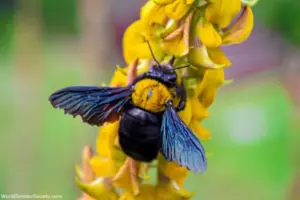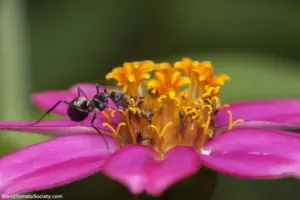Tomatoes are self-fertile, which means they don’t necessarily need the help of pollinators – they can pollinate themselves. That said, pollinators can help nudge the process forward by dislodging pollen and increasing fruit yields. When we think of pollinators, honeybees are often the first thing that comes to mind. Though effective, honeybees are just one of several awesome insects that do the same job, sometimes even better!
BumblebeesThe genus Bombus, commonly known as bumblebees, are large, fluffy flying insects that are well known for their pollination abilities. There are over 250 species of bumble, and they come in a wide range of colors. Often confused with carpenter bees, you can identify them by their hairy, floofy abdomens. Because of their large size, their presence shakes pollen loose as they land. |
 |
|
 |
Carpenter beesOften confused with beloved bumbles, carpenter bees have smooth, naked bottoms. Though bumblebees and carpenter bees share the same insect family as honeybees, they are often much larger. Carpenter bees belong to the genus Xylocopa and get their common names from their nesting behavior: Almost all species nest in dead wood or other hard plant material, such as bamboo. |
|
HawkmothsThough the larvae of one of these species are known as tomato pests – the tomato hornworm – the sphynx moths (aka hawk moths, family Sphingidae) are fantastic pollinators for tomatoes. Since tomato flowers are white to yellow in color, they are easily seen by these night-flying insects. The motion from their strong wings shakes pollen loose. |
 |
|
 |
AntsAnts are often overlooked as pollinators. However, several species are attracted to nectar or other insects on plants. Just by crawling around, they often shake pollen loose, helping along the pollination process in tomatoes. |
|
BeetlesThough many beetles can be considered pests, even more, are beneficial in one way or another. Some may feed on pests, while others’ hefty bodies shake tomato flowers, causing pollen to dislodge, and help complete the pollination process. |
 |
Lauren Davidson
World Tomato Society Entomology Expert
Readers Comments